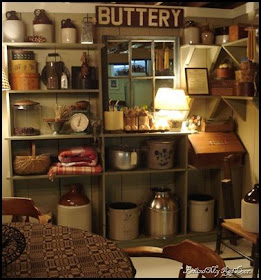Devil's Gate, or Devils Gate, is a natural rock
formation. It is a gorge on the Sweetwater River located five miles (8 km)
southwest of Independence Rock. Devil's Gate is a prime example of what is
called an antecedent drainage stream. The Sweetwater River cuts a narrow
100-meter deep slot through a granite ridge. If the same river had flowed less
than a kilometer to the south, it could have bypassed the ridge completely. The
gorge was cut because the landscape was originally buried by valley fill
sediments. As the river eroded downward through those sediments, once it hit granite,
it kept on cutting. The cleft is about 370 feet deep and 1,500 feet long. It is about thirty feet wide at the base, but 300 feet wide at the top.
 |
| Devil's gate by Wm. H. Jackson, 1870 |
Goldfish 49'er,
J.G. Bruff, wrote:
"...some of the boys clambered up the rock on the north side of the
Gate...where they fired pistols and threw down rocks, pleased with the
reverberation, which was great. I made a careful sketch of this remarkable
gorge."
According to American
Indian legend, they believed a powerful evil spirit in the form of a tremendous
beast with enormous tusks ravaged the Sweetwater Valley, preventing the Indians
from hunting and camping. A holy man told the tribes that the Great Spirit
wanted them to destroy the beast. The Indians launched an attack from the
mountain passes and ravines, shooting countless arrows into the evil monster.
Enraged, the beast with a mighty upward thrust of its tusks, ripped a gap in
the mountain and disappeared, never to be seen again.
Robert L. Munkees, “Independence Rock and Devil’s Gate” in Annals of
Wyoming, April 1968.
There are some creatures living around Devil’s Gate that might not be monsters, but they also are not something most people wish to cross their paths. Rattlesnakes. The rock formation of which Devil’s Gate is part is known as the Granite Hills. On an 1872 map, the mountains immediately north of them were identified at Rattlesnake Mountains.
My husband and I made a visit to some of the landmarks along the emigrant trail. Stopping near Devil’s Gate, a docent advised us we could walk to the river where we could have a better view of the water going through the gorge. He also warned us there are a lot of rattlesnakes there.
This author took a pass on hiking closer to Devil’s Gate.
Both Devil’s Gate and Independence Rock were landmarks on the three major emigrant trails: Oregon, California, and Mormon. The above drawing by William Henry Jackson, circa 1870, shows circled wagon trains at Independence Rock, with Devil's Gate in the distance.
Emigrant Charles E. Boyle wrote in 1849:
“Although the cleft was too narrow for wagons to pass through alongside the river, emigrants frequently stopped to hike around these rocks and carve their names. Often they noticed bighorn sheep climbing the hills. The chasm is one of the wonders of the world,… The water rushes roaring and raving into the gorge, and the noise it makes as it comes in contact with the huge fragments of rock lying in its course is almost deafening.”
 |
| Map by Ezra Meeker, 1907 |
As mountain men and adventurers began traveling west through the territory of the Louisiana Purchase, which became United States territory in 1803, they soon discovered Devil’s Gate. It became one of the landmarks which bordered what became a popular trail. The trail allowed wagons and livestock to cross the Continental Divide through South Pass, a reasonably smooth, gentle sloping pass over otherwise steep and rugged territory.
Fr. Pierre-Jean
DeSmet, S.J., said in 1841:
"...Travelers have named this spot the Devil's Entrance (Devil's Gate).
In my opinion they should have rather called it Heaven's Avenue."
Devil's Gate was a marker along the trail that many pioneers hoped would lead to a heaven on earth. However, there is far more to Devil’s Gate’s history than being a landmark. Next month, I will share about a trading post built near Devil’s Gate.
Pearl was my first book published in the Prairie Roses Collection (2022). Many of the same characters are in both Pearl and Clara. It also included the part of the story where the wagon train traveled passed Devil’s Gate as the wagons crossed the Sweetwater River nine times before reaching South Pass. The book is available as an ebook and in paperback, and also at no additional cost with a Kindle Unlimited subscription. To find the book description for Pearl and the purchase options, please CLICK HERE
Clara picks up Clara’s romance after the wagon train has already traveled the trail through the Sweetwater River valley. The book is currently available for purchase as an ebook or at no additional cost with a Kindle Unlimited subscription. To find the book description and purchase options, please CLICK HERE
Sources:
https://plantsandrocks.blogspot.com/2014/08/sweetwater-river-at-devils-gate.html
https://www.hmdb.org/m.asp?m=95488
https://en.wikipedia.org/wiki/Devil%27s_Gate_(Wyoming)







.jpg)
.jpg)
.jpg)
.jpg)

.jpg)

.jpg)

.jpg)



















